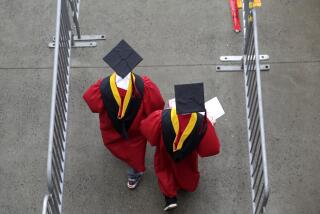When Dishing Out Thanks Today, Give a Serving to the Public Schools
Most of us will take some time today to give thanks for, or at least acknowledge, the great things in our lives.
But Iâll bet you werenât planning to include our public schools among them. Theyâve been a favored target for bashing from all quarters of society. Nearly everyone has an opinion about what schools are doing wrong.
Iâm going to take a holiday from all that and give you some reasons to be thankful for American public schools.
The reasons are many, according to Sandia, a research group based in New Mexico. They are outlined and supported in a recent report entitled âPerspectives on Education in America.â Many of these accomplishments may surprise even the most dogged school-watchers.
For example, high school students arenât as lazy and unskilled as some curmudgeons would have us believe. The percentage of Americans who graduate from high school has risen throughout this century, from 10% in 1910 to about 80% in 1990--and the figure rises to about 85% if you count the dropouts who return to pass the General Education Development (GED) test. Japanâs rate is 87% to 88%.
The dropout rate, meanwhile, has declined steadily. The trend is especially encouraging among black youths, whose dropout rate was below 15% in 1990, compared to 27% in 1970.
A lot is said about studentsâ math, science and reading skills, but consider some statistics from tests administered by the National Assessment of Educational Progress in 1988:
The tests found that math skills had improved from a decade earlier across the nation among 17-year-olds, especially minority teen-agers. In 1977, 70% of black students demonstrated basic proficiency; in 1986, 85% did so. Among Latinos, the basic proficiency rate rose to almost 90% from 78%.
Reading proficiency increased for 17-year-olds in all ethnic groups and communities; the scores of low-income urban students rose the most.
About 95% of American 17-year-olds have basic skills in science, a figure that has remained steady since 1977.
There is also good news on the Scholastic Aptitude Test (SAT) front, once you sort through the statistics. Most news reports focus on the national average SAT score. This can be misleading because in the last decade, the SAT has become more accessible. More students from lower-performing groups have been added to the traditional group of test-takers.
The truth is that since 1980, every subpopulation taking the SAT has shown improvement. So have the traditional SAT takers--the white, college-bound, middle- and upper-income students. Their SAT scores are up from about 900 in 1975 to about 975 in 1990.
Math scores have also increased on the Graduate Record Exam (GRE), which is required for entrance to graduate school, by 32 points from the low in 1974. The average GRE verbal score has remained stable.
Colleges and universities have also given us a few things to be thankful for, according to the Sandia report.
The percentage of Americans who receive four-year degrees continues to increase. It was 5% in 1940, 20% in 1980 and 25% in 1990.
In fact, the United States has the worldâs highest percentage of people with four-year degrees. We also have a more equitable gender distribution of degree-holders, and we produce a higher percentage of science and engineering majors than any other country.
Roughly three in every five U.S. students attempt some kind of postsecondary education; thatâs twice the number in Japan.
You may hear how technologically unprepared our graduates are. But since 1977, the number of college degrees in math, computer science, physical science, and engineering has risen more than 75%. Asian-Americans, blacks, Latinos and American Indians have increased their representation in these fields.
Add another âthank youâ for our college re-entry system, which is the worldâs most flexible and welcoming. American students can begin or resume their college educations at any age.
As a result, 42% of U.S. college students are 25 or older, the Sandia report says.
Hereâs an interesting comparison: The average American public school teacher has a masterâs degree or more; the average Japanese teacher has a bachelorâs degree or less, but is paid 50% more than his or her American counterpart.
Most of all, then, itâs time to be thankful for that incredible bargain known as the American public school teacher.
More to Read
Sign up for Essential California
The most important California stories and recommendations in your inbox every morning.
You may occasionally receive promotional content from the Los Angeles Times.










